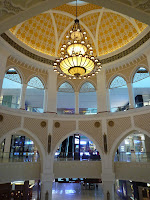English. A simple question deserves the shortest answer
While the term first language has various definitions, I think back to my school days in an Australian university filling up admin forms, and one of the form fields to fill was your first language. The Malaysian in me showed some hesitation. I had rarely come across the term ‘first language’, because in Malaysia if we were asked to single out any language, it’s probably to ask what your mother tongue is.
Arguably the term mother tongue, native language or ‘bahasa ibunda’ on the forms refers to the first language you are supposed to have learnt from your parents. In race-oriented Malaysia, they usually mean the language of one's ethnic background. For instance, if a Chinese like myself enters a government department, the officer would make snap judgments, “Religion: Buddha, Native tongue: Chinese, School: Some Chinese School”. That’s wrong, somewhat right and wrong. You see here that the term mother tongue, people’s own language etc. is associated solely on the colour of your skin.
And so I am heartened by the appellation ‘first language’ because it characterizes you as an individual with your own unique background, and not simply what is expected of you. Since there are various definitions out there, I’m going to give my own.
What Should Your First Language Be?
Your First Language should be:
- Your first language is the language you are most comfortable with.
- It’s the language you use in your head when you’re thinking to yourself (If you are adept at creating your own language, be sure to contact your nearest fantasy or alien movie producers for major motion picture deal)
- It’s most likely then language you learnt in your formative years. Environmental factors do factor in.
- It’s more often than not the language which your mastery of is the greatest where mastery includes vocabulary, grammar, slangs in use when communicating with other fellow speakers.
Exceptions abound for my definition of first language. I’ve known of people who are more comfortable in another language than the one they grew up with. One such person was adopted into a family during his teens and had to pick up a totally alien language which he eventually took as his first language.
I also know a whole bunch of people who speak Chinese dialects but because they never had formal Chinese education never learnt how to read and write the Chinese language. In today’s internet and knowledge driven world, they effectively know only half of the language, but they have enough to get by especially in one to one interactions.
Coming from a country with so many diverse and disparate cultures, I am witness to the many many forms of multilingualism. We are divided into ethnic groups but also social classes, urban or rural. I wrote more about it in a previous
article.
Where I Fit In
Where do I fit in? To be precise, my first Language is
Malaysian Standard English. I’d say that I’m a minority in a minority. I am what some might call an “English-educated” Chinese. But in today’s world, that is a misnomer. The fact is I went to national school. Everything I studied; science, mathematics, geography, history etc. was in the Malay Language or Bahasa Malaysia. That’s 13 years including 2 years of pre-university Form 6. English was just a language subject.
A dose of history: Back in the British Colonial days, there were schools of every kind. 1950s Malaysia was a different world then, English schools existed because they were setup by the British or missionaries. Obviously Britain controlled the economy, and as such, priority and favour were given to those who speak fluent English. There is a preconceived notion that English educated Malaysians were a class above came about, it’s not true though.
But in the 1970, all English schools met their demise. The new national education policy aimed to control and somewhat realign the syllabi of all schools in the country and more notably to turn once English-medium schools into Malay-medium ones. This policy shift arose in the wake of racial clashes in 1969 and is intended to ‘unify’ the nation. The Chinese, Tamil and Malay schools carried on, but the English schools were buried 6 feet under. Tell me, was it really the English educated who had a hand in the racial clashes? To me this was an excuse to get rid of what Malays reviled at the time, the English and all their influences in Malaysia.
While I may not be English educated, my parents were. They went to English schools because an English education presented the best opportunities to get ahead that competitive world. Whatever traditions they have, they passed on their on to me. I grew up reading lots of English books starting with Enid Blyton series. We had bought old Hollywood movies, cartoons and musicals in video cassette form. The internet was in its early years, though not as informative as this Wikipedia age.
English in the Malaysian media is alive and kicking. There are two main newspapers putting Malaysian Standard English into print, The New Straits Times and The Star. There are also a handful of English radio stations on the airwaves but local English TV programs other than news are scarce. The theatre scene in Kuala Lumpur is extraordinarily vibrant, modern and lively enough to attract a sustainable crowd.
And ultimately the Malaysian English speaking people like me will continue to persist and prosper in Malaysia but mostly in pockets concentrated in the more urban regions of Malaysia; I should know because I’m a product of it.
Back to School
But what really left a mark on my proficiency in English was my primary school which was a private school. That school taught me English as if it were my first language. I received 6 hours of English classes a week, which is on par with the learning of the Malay language. More importantly we were taught grammar but unfortunately not phonetics. It was not an English-medium school though, as all other subjects were in Malay. Nevertheless, most students I’ve interacted with are like me who use English as their primary language. I guess that’s how English was dominant in my formative years.
When I transferred to national school for my secondary education, I saw the great shortcomings in the teaching of the English Language subject in Malaysian public schools. The syllabus was incredibly easy-peasy. All the simple multiple choice questions, fill-in-the-blanks and the heavily guided compositions are all deliberately designed for the students to NOT master the English Language, which is a pity because with 4 hours a week, a lot of mastery can be gained.
While English in my first 3 years in lower secondary (leading up to PMR) was smooth sailing, the last two years of secondary (leading up to SPM) were very different. We had a very enthusiastic English teacher who was the head of the English Department at our school. In those two years, our English advanced like never before. She had organised debates, speech and story writing competitions, encouraged us to read more mature forms of literature and even verging on theatre. She expected a lot from us, and we delivered, at least my class did. She corrected our grammar and made sure everyone knew about it; and we had a vocabulary book just like I had in primary school where we jot down new words that we come across.
Alas my English Language slide was corrected. Later in life I found out that this was an anomaly, most of my peers in college never had such an English coach. Her lesson plan clearly deviated from what the government prescribed, as she took her lonely stand against the deterioration of English in Malaysia and for this I owe her much thanks.
The Others (Dan Lain-lain)
In Malaysia, being Chinese and not knowing Chinese earned me the moniker ‘Banana’, that’s yellow on the outside, white on the inside. Am I supposed to feel ashamed because the sound of my tongue doesn’t suit the colour of my skin? Am I supposed to look, think, sound like the others. Well, firstly I think that ancestral identity is overrated. What should matter more is your own personal history. In this case, be proud of the way you’re brought up, but work toward a better you and a better future for your family.
My second language is easily Bahasa Malaysia since the schools I attended were Malay-medium. However my usage of the language is restricted to the academic purposes because it’s really not suitable for the streets. Street Malay is devoid of all the grammar and tenses of formal Malay, complete with its own vocabulary and chronically shortened. I have some Chinese friends who speak colloquial Malay with all the slangs and what not. That comes with lots of interaction with Malay friends, interactions which I never really had. I only wish that colloquial Malay sounded more like proper Malay, so that my Malay education doesn’t totally go to waste.
As for mandarin, I did learn little of it in my primary school, but my grasp on that wee bit of language is slipping away. I grew up on Penang Hokkien, which is virtually useless where I’m staying in the Klang Valley. As far as the Klang Valley region is concerned, Cantonese is the predominant Chinese dialect, and I did pick up bits of the language especially from my colleagues and now can order food confidently.
From years slaving away in the working environment, I feel that the need to master mandarin is greater than before. English educated Chinese families have been leaving Malaysia in droves over the decades leaving all the Chinese educated ones behind. Indeed in many industries and corporations the Chinese educated rule the roost. Pax Americana and other Anglophone countries today are on the decline in contrast to an ascending China which has yet to see the top of the hill. And you bet I’m going to take classes in the future.
To many people, their language is solidly tied to their culture. I am no different. It reflects my childhood, background and upbringing. And no matter what people say and no matter how many languages I may or may not master in the future, I’m proud to declare that English is my first language now and always.





























